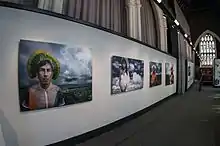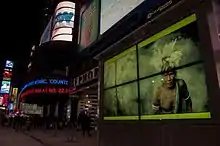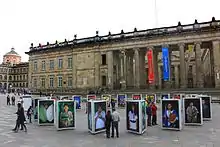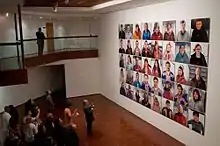Antonio Briceño
Antonio Briceño (born 5 December 1966[1] in Caracas, Venezuela) is a professional photographer and has been a passionate activist in environmental issues, as well as in ethnic minorities and human rights. He has a graduate degree in Biology from the Central University of Venezuela (Caracas, 1993) and a master's degree in Digital Arts from the Pompeu Fabra University (Barcelona, 2015), and he is the co-founder of the prestigious conservationist nongovernmental organization PROVITA.
Biography





Briceño's passion for photography began when he was a teenager and he first exhibited his work in 1987. Between 1996 and 2002, he carried out several solo exhibitions, relating to the following topics: Veils and Turbans (1996, Lalit Kala Akademi, New Delhi); Passengers (a series that won him First Prize in the Luis Felipe Toro Prize and which was exhibited in Caracas' Museum of Fine Arts in 1997); Devotion (a series that depicts different forms of popular religious beliefs in Venezuela, which was shown at Galería Los Talleres, Mexico in 1998; in Casa de las Américas, Havana, 1999; and at Maison Internationale, Brussels in 2000); Guadalupanos (Ateneo de Caracas, 1999); and The Shamans (Galerie Adriana Schmidt, Stuttgart, 2002).
Between 2001 and 2007, he worked on the project entitled Gods of America: Natural Pantheon, in which he used digital photomontage (carried out during long-term periods of field research), creating a pantheon of deities and mythological beings from indigenous cultures across the American continent. This project covered ten cultures from six countries: Huichol (Mexico 2001), Piaroa (Venezuela 2002), Kogui and Wiwa (Colombia 2003), Wayuu (Venezuela 2005), Kuna (Panama 2005), Quero (Peru 2005), Kayapó (Brazil 2006), and Ye'Kuana and Pemón (Venezuela 2007). He received several grants that allowed him to carry out the project, including grants from the Programa de Intercambio de Residencias Artísticas (Grupo de los Tres G3), the Estancia para Creación Artística Grant (Government of Mexico) and the Apoyo an Artistas Grant, (Centro Nacional de las Artes, Mexico).
Gods of America represented Venezuela at the 52nd Venice Biennale (2007)[2][3][4] and have been exhibited, in either solo or group shows, in Finland, France, Hungary, Sweden,[5] Germany,[6] the United Kingdom, Spain,[7] the United States,[8][9] Mexico, Colombia, New Zealand [10] and Venezuela. The artist received the Green Leaf Award for Artistic Excellence 2008, awarded by the Natural World Museum and the United Nations Environment Program for this compelling series, in addition to various other prizes and highly commented awards in his home country, Venezuela.
In 2008, Briceño carried out a project entitled The Tree, in which he photographed the New Zealand Maori's worship of forefathers. Afterwards, in 2009, the Colombian Ministry of Culture invited him to create a series about the current situation of indigenous groups in their country, which resulted in the exhibit Look at us. Here we are in Bogotá and other cities around Colombia.
The same year he was invited by the Government of Finland and the Sámi Parliament to carry out the project 520 Reindeer. A homage to Sàmi language, which depicts the richness and importance of the languages of the Sámi, who are the last surviving indigenous people in Western Europe. This series has been exhibited in Venezuela and in Finland, and one of its main pieces was presented at the headquarters of the United Nations in New York during the Indigenous Peoples and Food Sovereignty exhibition. Now, the complete series belongs to the Sámi people SIIDA Museum in Inari, Finland.
In 2010, the institution Art Works for Change and the United Nations Environment Program invited him to carry out an artistic project on biodiversity in Rwanda, which he entitled Millions of pieces. One Puzzle. This series was presented during on the occasion of the World Environment Day celebrations of 2010, and it was exhibited at the Field Museum in Chicago. Two years later, in 2012, the artist presented The weepers. Our last tears (hired female mourners), a series consecrated to the repression of emotions, so characteristic of our contemporary culture, produced entirely in Northern Peru. That same year, he received the 2011 International Association of Art Critics Award [11] for his outstanding career and commitment to the expression of a poetics of respect for the planet, its inhabitants and its cultures.
Most recently, in 2014, Briceño presented the series Omertà on oil. The era of silence, a video installation consisting on several video-portraits of victims of torture and other forms of disproportionate use of force by the military and paramilitary groups controlled by the government of Nicolas Maduro, during the civil protest and demonstrations that took place on February and March of that same year. Furthermore, his last series to this day, The skin of Mars, reflects precisely on the violence of war and the scars we bear as species and as individuals through the overlapping of images of planet Mars taken by NASA and pictures of as many sculptures of the homonymous god that rest in the collections of art museums around the world.
Finally, in addition to his personal artistic endeavours, the artist has often collaborated with conservationist organizations: in 2007 he worked for Conservation International documenting the institution's cooperation programs for the Ye'kuana people in Venezuela, and in 2012 he photographed the Pumé and Yopal communities, also in Venezuela, for The Nature Conservancy. Likewise, he has been invited to join the jury of the annual photography contest sponsored by PROVITA and the IUCN.
References
- "Antonio Briceño". The Gabarron. Retrieved 17 March 2017.
- Binder, Universes in Universe - Gerhard Haupt & Pat. "Venezuela, Venice Biennial 2007".
- "Londonart.co.uk Magazine".
- Toro, Simon (4 May 2009). "Dioses de América" – via Vimeo.
- "ANTONIO BRICENO 13 mars – 16 mars 2008 – EDSVIK KONSTHALL".
- "Ibero-Amerikanisches Institut: Veranstaltungsarchiv".
- "Getxophoto 2007".
- "Photographs of indigenous cultures by Antonio Briceño and Attila Lóránt - artnet Magazine".
- http://gabarron.org/NewYork/Exhibitions/PastExhibitions/SavetheForestSavetheCulture/Cover/tabid/257/Default.aspx
- "Moving Towards a Balanced Earth". 4 January 2015.
- "AICA Venezuela anuncia los Premios de la Crítica 2011 - tráfico visual".